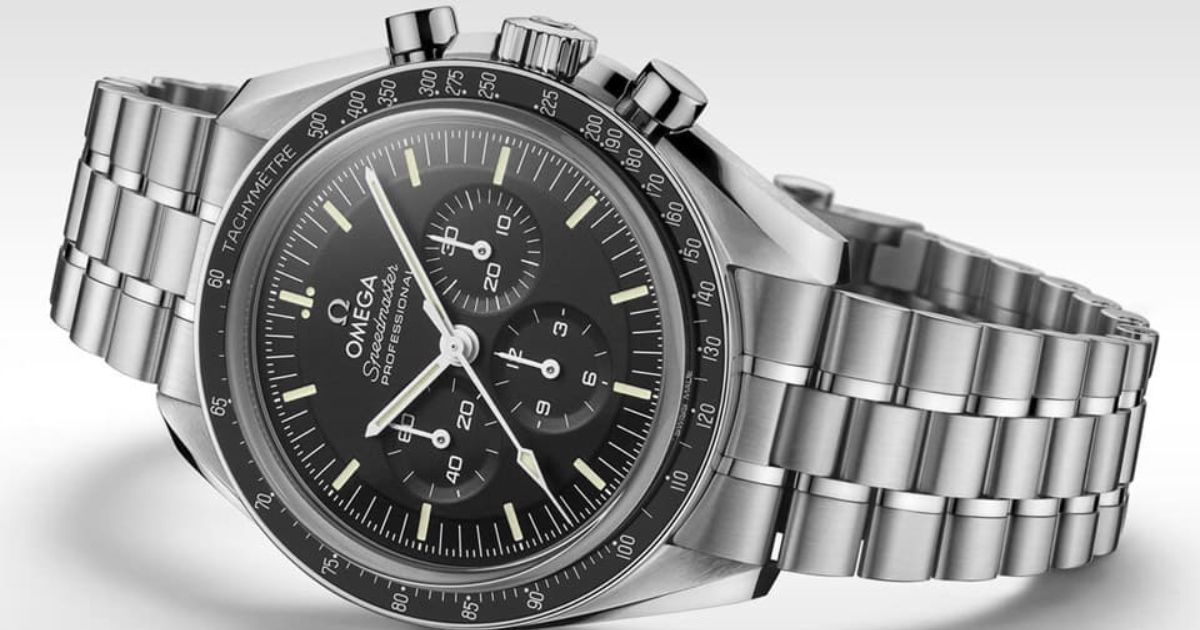Blog
The Story Behind the Speedmaster: How a Watch Went to the Moon

If you’re here, reading this on a blog dedicated to high-end timepieces, you already know the Omega Speedmaster Professional. It’s the “Moonwatch.” That title is so deeply etched into its identity that it’s easy to forget it had a life, a story, long before it ever left Earth’s atmosphere. The journey of the Speedmaster from a stylish chronograph for racing car drivers and scientists to a piece of mandatory equipment for the most daring explorers in human history is a tale of serendipity, rigorous testing, and timeless design.
Today, we’re diving into the story behind the watch. This isn’t just about what happened, but how and why.
The Birth of a Tool Watch (1957)
Long before it was a lunar legend, the Speedmaster was born as part of Omega’s “Professional” trilogy, alongside the Railmaster and Seamaster 300. Launched in 1957, its initial purpose was terrestrial. The post-war era was a time of technical innovation and a growing fascination with speed and science. The Speedmaster Ref. CK2915 was designed as a robust, legible chronograph for engineers, technicians, and sports car drivers.
Its key features, which would later prove crucial in space, were all developed for Earth-bound use:
- The black, metal tachymeter bezel was for measuring average speed.
- The high-contrast “panda” dial (black with light-colored sub-dials) ensured maximum legibility.
- The broad arrow hands, and later the iconic lollipop-shaped seconds hand, made telling the time at a glance effortless.
- Its robust, manually-wound movement, the Calibre 321, was a masterpiece of chronograph engineering.
It was a brilliant tool watch, but it was one of several in a crowded market. Its destiny, however, was written in the stars.
The “Right Stuff” and the Right Watch
As the Space Race heated up in the early 1960s, NASA was methodically equipping its astronauts for the unknown. The astronauts themselves, many of whom were test pilots, were given a stipend to purchase their own wristwatches. They needed a reliable chronograph for timing engine burns and other critical maneuvers.
In 1964, without fanfare, NASA began a secret, brutal procurement process for a wristwatch. They anonymously purchased a number of chronographs from retailers, including models from Rolex, Longines, and Omega.
What followed was a series of tests so extreme they are the stuff of horological legend. The watches were subjected to:
- High Temperature: 160°F (71°C) for 48 hours, then 200°F (93°C) for 30 minutes.
- Low Temperature: 0°F (-18°C) for 4 hours.
- Temperature-Pressure Vacuum: Cycling from -18°C to +93°C in a near-vacuum.
- Humidity: Relative humidity of 95% for 14 days.
- Corrosion: An oxygen-rich 100% atmosphere for 2 days.
- Shocks: Six 40G shocks in different directions.
- Acceleration: From 1 to 7.25 Gs for over 300 seconds.
- Vibration: Three 30-minute cycles from 5 to 2000 cycles per second.
- Acoustic Noise: 130 decibels at frequencies from 40 to 10,000 Hz for over 30 minutes.
One by one, the other watches failed. Only one survived: the Omega Speedmaster Professional Ref. 105.003. It emerged still running, its crystal the only casualty (it had popped out during the high-pressure test, but was reinstated for the remainder of the trials). In March 1965, NASA officially qualified the Omega Speedmaster for all manned space missions.
Proving Its Mettle: Gemini and Apollo
The Speedmaster’s first spacewalk wasn’t on the moon, but during the Gemini program. In June 1965, astronaut Ed White made America’s first Extra-Vehicular Activity (EVA), and strapped to his wrist was his personal Speedmaster. The images were beamed back to Earth, forever linking the watch with the romance of space exploration.
But its true test came during the Apollo program. Every Apollo astronaut was issued a Speedmaster. It was there for the first lunar orbit on Apollo 8, and it was there for the “one small step” on Apollo 11. When Buzz Aldrin descended the ladder of the Lunar Module onto the Sea of Tranquility, he became the second man on the moon, and his Speedmaster became the first watch on the moon. (Neil Armstrong had left his in the Lunar Module as a backup after the cabin’s electronic timer failed).
The most dramatic chapter in the Speedmaster’s story, however, was written during the ill-fated Apollo 13 mission. After an oxygen tank exploded, crippling the spacecraft, the crew had to use the Lunar Module as a lifeboat. With electrical power severely limited, they were forced to navigate manually. To execute the critical 14-second engine burn for a course correction, the crew used their hand-wound Omega Speedmasters. Jack Swigert timed the burn on his wrist, while Jim Lovell steered using the Earth’s terminator as a guide. This precise timing was vital for a safe re-entry into Earth’s atmosphere. For this role in bringing the crew home safely, Omega received NASA’s “Snoopy Award,” an honor for outstanding contributions to mission success.
The Evolution of an Icon
The Speedmaster that went to the moon wasn’t identical to the one we see today. The reference evolved. The “Pre-Moon” models (like the 105.012) worn on Apollo 11 had a symmetrical case and the legendary Calibre 321. In 1968, Omega introduced the Ref. 145.022, which featured an asymmetrical case designed to better protect the crystal and pushers, and housed the new, robust Calibre 861.
This is the reference that solidified the “Moonwatch” design we know today: the Hesalite crystal (chosen because it doesn’t shatter and can withstand greater pressure than sapphire), the twisted lugs, and the engraved caseback detailing its flight qualification.
The beauty of the modern Speedmaster Professional “Moonwatch” is its profound connection to this history. Wearing one is not just wearing a watch; it’s wearing a piece of engineering history. It’s a direct descendant of the tool that survived NASA’s tests, walked on the moon, and helped save the lives of three astronauts.
Conclusion: More Than a Watch
The Omega Speedmaster’s journey to the moon was not the result of a marketing campaign, but of proven performance under the most extreme conditions imaginable. It earned its title the hard way. For us as collectors and enthusiasts, the Speedmaster represents the pinnacle of the “tool watch” philosophy. It’s a reminder of a time when human courage and mechanical ingenuity worked in perfect harmony to push the boundaries of the possible.
It’s a story told not in words, but in ticks of a seconds hand, timed on a chronograph that, quite literally, has been to the moon and back.























































